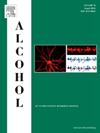Effect of high mobility group box 1 pathway inhibition on gene expression in the prefrontal cortex of mice exposed to alcohol
IF 2.9
4区 医学
Q3 PHARMACOLOGY & PHARMACY
引用次数: 0
Abstract
Introduction
The high mobility group box 1 (HMGB1) pathway plays a pivotal role in the development of alcohol-induced brain injury. Glycyrrhizinic acid (GlyA) is widely regarded as an inhibitor of HMGB1. The objective is to investigate the impact on gene expression in the prefrontal cortex,we sequenced the transcriptome in control, alcohol-exposed, and HMGB1-inhibited groups of mice. We verified our findings by real-time quantitative PCR (qRT-PCR).
Methods
An alcohol exposure model was established in mice by intraperitoneal injection of alcohol. Transcriptome sequencing and bioinformatics analyses were performed on prefrontal cortex tissue. Kyoto Encyclopedia of Genes and Genomes analysis was performed to identify pivotal pathways of differentially expressed genes. The role of relevant genes was verified by qRT-PCR.
Results
Expression of genes involved in the neuroactive ligand–receptor interaction pathway exhibited an increase in mice from the alcohol-exposed group. However, there were no significant differences observed in the expression of these genes between control and those receiving an intraperitoneal injection of alcohol along with a HMGB1 inhibitor. Mice in the alcohol-exposed group showed increased gene expression of Cysltr2, Chrna6, Chrna3, Chrnb4, and Pmch. Expression of these genes was decreased in mice injected with HMGB1 inhibitor.
Significance
Our study demonstrates that alcohol primarily influences gene expression in the prefrontal cortex of mice through the neuroactive ligand–receptor interaction pathway. HMGB1 inhibitor effectively inhibited the expression of this pathway. This study provides a novel route for drug development in alcohol-induced brain injury.
高迁移率组框 1 通路抑制对暴露于酒精的小鼠前额叶皮层基因表达的影响。
简介高迁移率基团框 1(HMGB1)通路在酒精诱发的脑损伤发展过程中起着关键作用。甘草酸(GlyA)被广泛认为是 HMGB1 的抑制剂。我们对对照组、酒精暴露组和 HMGB1 抑制组小鼠的转录组进行了测序。我们通过实时定量 PCR(qRT-PCR)验证了我们的研究结果:方法:通过腹腔注射酒精建立小鼠酒精暴露模型。对前额叶皮层组织进行了转录组测序和生物信息学分析。对京都基因和基因组百科全书进行了分析,以确定差异表达基因的关键通路。通过 qRT-PCR 验证了相关基因的作用:结果:参与神经活性配体-受体相互作用通路的基因在酒精暴露组小鼠中的表达量有所增加,但这些基因的表达量在对照组与腹腔注射酒精和 HMGB1 抑制剂的小鼠之间没有观察到显著差异。酒精暴露组小鼠的 Cysltr2、Chrna6、Chrna3、Chrnb4 和 Pmch 基因表达量增加。注射了 HMGB1 抑制剂的小鼠这些基因的表达量减少:我们的研究表明,酒精主要通过神经活性配体-受体相互作用途径影响小鼠前额叶皮层的基因表达。HMGB1抑制剂能有效抑制这一途径的表达。这项研究为开发治疗酒精所致脑损伤的药物提供了一条新途径。
本文章由计算机程序翻译,如有差异,请以英文原文为准。
求助全文
约1分钟内获得全文
求助全文
来源期刊

Alcohol
医学-毒理学
CiteScore
4.60
自引率
4.30%
发文量
74
审稿时长
15.6 weeks
期刊介绍:
Alcohol is an international, peer-reviewed journal that is devoted to publishing multi-disciplinary biomedical research on all aspects of the actions or effects of alcohol on the nervous system or on other organ systems. Emphasis is given to studies into the causes and consequences of alcohol abuse and alcoholism, and biomedical aspects of diagnosis, etiology, treatment or prevention of alcohol-related health effects.
Intended for both research scientists and practicing clinicians, the journal publishes original research on the neurobiological, neurobehavioral, and pathophysiological processes associated with alcohol drinking, alcohol abuse, alcohol-seeking behavior, tolerance, dependence, withdrawal, protracted abstinence, and relapse. In addition, the journal reports studies on the effects alcohol on brain mechanisms of neuroplasticity over the life span, biological factors associated with adolescent alcohol abuse, pharmacotherapeutic strategies in the treatment of alcoholism, biological and biochemical markers of alcohol abuse and alcoholism, pathological effects of uncontrolled drinking, biomedical and molecular factors in the effects on liver, immune system, and other organ systems, and biomedical aspects of fetal alcohol spectrum disorder including mechanisms of damage, diagnosis and early detection, treatment, and prevention. Articles are published from all levels of biomedical inquiry, including the following: molecular and cellular studies of alcohol''s actions in vitro and in vivo; animal model studies of genetic, pharmacological, behavioral, developmental or pathophysiological aspects of alcohol; human studies of genetic, behavioral, cognitive, neuroimaging, or pathological aspects of alcohol drinking; clinical studies of diagnosis (including dual diagnosis), treatment, prevention, and epidemiology. The journal will publish 9 issues per year; the accepted abbreviation for Alcohol for bibliographic citation is Alcohol.
 求助内容:
求助内容: 应助结果提醒方式:
应助结果提醒方式:


